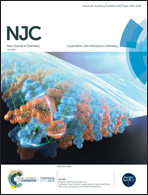Theoretical investigation on the mechanism of glucose-to-fructose isomerization synergistically catalyzed by MnCl2 and [C4SO3HMIM][CH3SO3] in [BMIM]Cl†
Abstract
The mechanism of glucose-to-fructose isomerization catalyzed by manganese chloride (MnCl2) and 1-methyl-3-(3-sulfobutyl)-imidazolium methylsulfonate ([C4SO3HMIM][CH3SO3]) in a 1-butyl-3-methylimidazolium chloride ([BMIM]Cl) ionic liquid (IL) was investigated computationally. The results show that the reaction involves four processes: ring opening, proton transfer, 1,2-H migration, and ring closure. The 1,2-H migration with an overall free energy barrier of 33.0 kcal mol−1 is identified as the rate-controlling step. Throughout these four processes, the Mn center plays the role of a Lewis acid, which stabilizes the intermediates and the transition states via coordinating with both glucose and chlorine anions. The cation and anion of [C4SO3HMIM][CH3SO3] act as a Brønsted acid and base, respectively, to promote a series of proton transfer processes. [BMIM]Cl provides a polar environment to stabilize all charge-separated structures. The present results provide help for rationalizing the mechanism of glucose-to-fructose isomerization catalyzed by metal salts and SO3H-functioned ILs in imidazolium-based ILs, and give guidance for the design of efficient catalysts for glucose-to-fructose isomerization.
![Graphical abstract: Theoretical investigation on the mechanism of glucose-to-fructose isomerization synergistically catalyzed by MnCl2 and [C4SO3HMIM][CH3SO3] in [BMIM]Cl](/en/Image/Get?imageInfo.ImageType=GA&imageInfo.ImageIdentifier.ManuscriptID=C8NJ05988H&imageInfo.ImageIdentifier.Year=2019)


 Please wait while we load your content...
Please wait while we load your content...